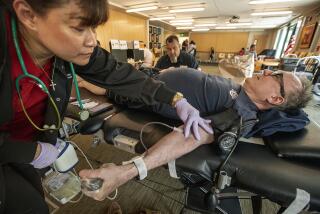Independent Blood Banks Review Safety : Health: Association of 2,400 centers intends to adopt a stricter ‘quality assurance’ program. Plans predate announcement of a Red Cross effort.
- Share via
WASHINGTON — The nation’s 2,400 independent blood banks plan a two-year program to improve the safety of their blood and blood products, an effort that predates a similar campaign just announced by the American Red Cross, a top industry official said Tuesday.
“We have problems, too. I wouldn’t want to leave the impression that all (American Assn. of Blood Banks) members are squeaky clean,” said Joel M. Solomon, new chief executive officer of the group, whose members supply about half the blood used in the United States.
The trade association’s members, together with the 53 blood centers operated by the American Red Cross, collect a combined total of 12 million blood donations a year, meeting virtually all the nation’s needs for blood and blood products.
Solomon discussed the American Assn. of Blood Banks’ intention to adopt a more stringent “quality assurance” program in an interview Tuesday--one day after the American Red Cross had announced a $100-million overhaul of the way it collects and handles blood. But Solomon said that his organization began discussing its plans to adopt new safety measures more than six months ago.
Details of the program will be determined by special committees to be appointed this autumn by the organization’s board of directors. But Solomon said that the changes are not likely to be as extensive as the reorganization announced Monday by the Red Cross. That is because each of the association’s centers is a free-standing, independent entity and hence not part of a large bureaucracy that needs a massive overhaul of its infrastructure, Solomon said.
The program is apt to focus more narrowly on quality control standards and guidelines designed to ensure, for instance, that supplies and handling procedures are followed meticulously and that tests are performed and recorded accurately.
“It would be to prevent errors at the end of the process,” Solomon said. He predicted that the new program will be in place “within two years.”
Public concern over the safety of the nation’s blood supply has risen in recent years as federal regulators and congressional investigators have uncovered instances in which blood and blood products were shipped for transfusion even though they were contaminated by viruses that cause AIDS and various forms of hepatitis.
The Food and Drug Administration, which is required by law to inspect every blood center annually, has found that Red Cross centers not only have released contaminated blood for shipment but also that they repeatedly have failed to report such errors to the federal agency.
The task of managing blood has become vastly more difficult in recent years. Red Cross centers had to perform 100 million more tests on donated blood between 1984 and 1990 than during the comparable period before 1984. Such burdens have put new strains on the system, requiring more staff hours as well as more sophisticated and centralized record-keeping systems.
The third, and much smaller, source of blood in the United States is the Armed Services Blood Program, run by the Pentagon. It also is subject to FDA regulation.
One of the first steps in the Red Cross overhaul will be to consolidate 10 computer systems into one, Red Cross officials said. The plan, to be implemented on a staggered basis by region, also would centralize blood testing. Under current procedures, a small sample of each unit of donated blood is tested at each regional blood bank. The changes are to begin early next year.
The increasing government scrutiny of blood banks has led to the recent closures of several blood banks throughout the country, including facilities in Charleston, S.C., Portland, Ore., and Lincoln, Neb.
Solomon took over as the top official at the blood banks association, based in Arlington, Va., last spring after serving as director of FDA’s division of blood and blood products.
As a government official, he had written of the need for blood banks to recognize that much of their work is similar to manufacturing and thus requires certain quality-control features to guarantee the safety of the final product.
“And that’s one of the reasons why I’m now here at AABB--the opportunity to take some of those ideas and translate them into action,” Solomon said.
More to Read
Sign up for Essential California
The most important California stories and recommendations in your inbox every morning.
You may occasionally receive promotional content from the Los Angeles Times.













